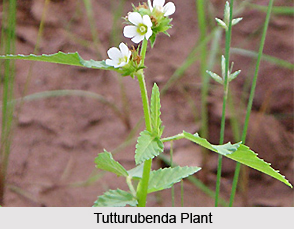 Tutturubenda is an annual or perennial woody herb which is found everywhere in the tropical and subtropical regions of India. The Botanical name of Tutturubenda is Melochia corchorifolia L. It is called by various other names in different languages in India like Tikiokra in Bengali, Seruvuram in Malayalam, Pinnakkup-Pundu and Punnakkukkirai in Tamil, Bilpat in Hindi, Chyeron, Nolita and Dasokerotan in Oriya and Ganu-Gapindikura and Sittantakura in Telugu.
Tutturubenda is an annual or perennial woody herb which is found everywhere in the tropical and subtropical regions of India. The Botanical name of Tutturubenda is Melochia corchorifolia L. It is called by various other names in different languages in India like Tikiokra in Bengali, Seruvuram in Malayalam, Pinnakkup-Pundu and Punnakkukkirai in Tamil, Bilpat in Hindi, Chyeron, Nolita and Dasokerotan in Oriya and Ganu-Gapindikura and Sittantakura in Telugu.
Tutturubenda is an erect, branched, annual or perennial woody herb which is 0.1 to 2.5 meters tall, with nearly glabrous stems and branches. The leaves of this plant are extremely variable in shape and size, oblong-lanceolate, narrowly ovate and are 2.5 to 10 centimetres long and 1.2 to 7 centimetres wide. The apex is acute, base cuneate to truncate, margins are crenate-serrate, sometimes obscurely lobed, and glabrous on both surfaces or with a few scattered stellate hairs. The petioles are 0.3 to 2.5 centimeters long and slender. The stipules are lanceolate, ciliate and are 0.3 to 1 centimeters long. Flowers of Tutturubenda are small, white or pink in colour, densely clustered in axillary and terminal or cymes. Fruits (capsules) of this plant are depressed globose, pea-sized with sparsely hairy valves. The seeds are angular, mottled black and grey and are not winged.
Tutturubenda is very widely distributed in the Old World tropics and subtropics; introduced into the New World, and became widespread in the southern USA and elsewhere. This plant is present throughout the subtropical and tropical India from Kumaon to Sikkim at an altitude of 1200 meters, southwards through the state of Madhya Pradesh, Maharashtra, Gujarat, Tamil Nadu and Karnataka. Tutturubenda is typically found in shady, moist habitats along river-banks and streams, forest margins and in disturbed habitats such as fallow fields and roadsides. The fruits and flowers of this plant are seen from the months of September to October in the dry deciduous forests of northern Maharashtra state.
Tutturubenda is also a plant of great medicinal use in India. The leaves and stems of this plant, boiled in oil, are used on the Malabar Coast as a remedy for bites from water-snakes. A decoction of the roots and leaves of this Indian medicinal plant is used for the treatment of dysentery.



















